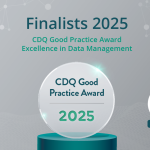The e-invoicing reality: the gateway is ready, but is your data?

E-invoicing began making headlines as a helpful and modern efficiency measure, and evolved into a central element of regulatory compliance. Over the past decade, the EU has steadily shifted from encouraging electronic invoices to mandating them. And while the technology obviously plays an important part in the process, the software rarely is the one to blame when things go wrong.
The key point is simple:e-invoicing process will only be as good as the data feeding it. Plus, in the age of mandatory structured e-invoices, unreliable data can be incredibly costly.
- Example: big consequences of a small error
A mid-sized electronics distributor onboarding a new supplier mistypes a VAT ID during setup. The ERP accepts the value, but once invoices are transmitted via the national e-invoicing platform, the system rejects every invoice linked to that supplier. Within two weeks, 28 invoices fail, delaying payment cycles and triggering supplier complaints, all because of a single incorrect character.
The EU has been methodical in its approach. Directive 2014/55/EU set the first concrete requirements, mandating that all EU public administrations be able to receive and process e-invoices compliant with the EN 16931 semantic standard. The aim was interoperability: an invoice issued in one member state must be readable and processable in another without manual rework. Simple enough in theory, but the practical challenges soon became clear.
Fast forward to today, with the ViDA reform officially adopted in March 2025, the countdown has started. By July 2030, all intra-EU B2B and B2G transactions will require structured, machine-readable e-invoices. That means no paper, no free-form PDFs, and no excuses for poor supplier data.
Early adopters like Poland’s KSEF platform show that while the technology exists, the real bottleneck lies in trusted master data: without it, automated systems cannot prevent errors, invoice rejections, or regulatory breaches. Meanwhile, PEPPOL adoption has grown to over 1.4 million organizations, standardizing cross-border invoice exchange. But even this powerful infrastructure is only as effective as the underlying data.
The master data groundwork is non-negotiable
An invoice is a structured representation of a business transaction. Its reliability depends entirely on the data feeding it: legal names, VAT IDs, addresses, and classifications are critical compliance touchpoints. Missing or inconsistent information immediately risks rejection.
You can invest in every ERP module, deploy advanced invoice engines, and integrate PEPPOL connectivity, but without clean, complete and trusted master data, all of it becomes a fragile house of cards. Legal entity names, VAT IDs, addresses, and business classifications must be accurate, complete, and consistently maintained.
- Scenario: Duplicate supplier records in the ERP
A global manufacturer stores a supplier twice: one outdated record from 2016 and one created urgently during a system migration. When an invoice is generated, the system selects the older record due to an unnoticed routing rule. The invoice reaches the national gateway with an obsolete address and is immediately rejected, sending the finance team on a troubleshooting quest.
Inconsistent supplier master data, incomplete records or wrong mapping across systems is a roadblock for the smartest e-processes and a single erroneous VAT ID, an ambiguous business name, or multiple addresses for the same entity can trigger a cascade of operational issues. Errors propagate across the entire ecosystem.
- Field-level example: EN 16931 misalignment
An internal ERP stores VAT IDs in a free-text field allowing spaces and punctuation. EN 16931 requires the VAT ID to meet strict format rules. A French VAT ID stored as "FR 123 456 78901" (with spaces) appears correct to a human but fails machine validation during e-invoice transmission.
Key fact: EN 16931 defines a semantic core model that standardizes invoice fields and business rules, enabling cross-border interoperability. Without alignment to this model, automated invoice processing is significantly compromised.
Clean master data reduces errors and manual intervention, accelerates validation and approval workflows, and ensures regulatory compliance. Beyond internal operations, it improves relationships with suppliers by reducing disputes and delays, and it protects the supply chain from unnecessary disruptions.
The EU regulatory landscape
The e-invoicing ecosystem intersects with multiple regulatory frameworks, each with its own implications:
- Directive 2014/55/EU: Established the requirement for public administrations to accept e-invoices in a standardized format.
- EN 16931: Provides the semantic model ensuring machine-readable invoices are interoperable across the EU.
- ViDA (VAT in the Digital Age): By 2030, all intra-EU B2B and B2G transactions must comply with structured e-invoicing standards.
- PEPPOL (Pan-European Public Procurement Online): Facilitates cross-border exchange, connecting over 1.4 million organizations, but relies on upstream data accuracy.
- CSRD / ESRS (Corporate Sustainability Reporting Directive/ European Sustainability Reporting Standards): Require traceable and auditable ESG reporting.
- CSDDD (Corporate Sustainability Due Diligence Directive): Adds obligations for companies to identify and remediate supply chain human rights and environmental risks.
- AI Act & Digital Markets Acts: Introduce transparency and governance expectations for AI systems and broader digital compliance.
Can you honestly claim your supplier data is fully aligned with these intersecting regulations? Or maybe you’re still treating e-invoicing as just another software upgrade?
If one small error in a VAT ID or business classification can lead to invoice rejection, you’re risking audit failures, fines, and operational delays.
Common data challenges in e-invoicing
Modern invoice engines, ERP systems, and PEPPOL gateways are capable of handling the new e-invoicing standards as long as the underlying data is correct. The practical challenges often come down to mapping and consistency. Most ERP systems were originally designed around general accounting functions, not semantic interoperability. As a result:
- Multiple addresses, alternative names, or ambiguous legal identifiers create mismatches.
- Internal master records rarely match the EN 16931 semantic model perfectly.
- Inconsistent or incomplete data record trigger manual corrections, slow invoice processing, and increase audit risks.
Even organizations participating in PEPPOL experience these issues. While PEPPOL dramatically simplifies the technical exchange, it exposes upstream inconsistencies but won’t fix your supplier records for you. As long as your ERP records, supplier lists, and internal data repositories are inconsistent or incomplete, this misalignment will translate directly into invoice failures.
Trusted data as the e-nabler
When master data is clean and standardized, you’re reducing errors, allowing automated processes to run smoothly without manual intervention. Validation and approval workflows become faster, and compliance with regulations is much easier to demonstrate during audits. Reliable data also propagates to downstream systems, including tax reporting and other financial applications, maintaining consistency across the enterprise.
Suppliers benefit too: correct invoices mean fewer disputes, on-time payments, and smoother collaboration. And when the data is accurate, supply chain processes remain uninterrupted, avoiding the cascading effects of misdeliveries or financial discrepancies.
Practical benefits of clean master data:
- Reduced errors and rejected invoices
- Faster validation and approval workflows
- Compliance assurance and audit readiness
- Better integration with ERP, tax reporting, and downstream systems
- Improved supplier relations and supply chain reliability
Fact: Organizations with clean and validated supplier master data see significantly fewer invoice rejections, faster payment cycles, and lower compliance risk.
Multilayer e-invoicing framework
An effective e-invoicing system starts with supplier onboarding. Accurate VAT IDs, legal names, addresses, and classifications must be verified at the point of entry. This is followed by a validation and enrichment layer, where internal records are mapped to the EN 16931 semantic fields. Mandatory versus optional fields are checked, business rules applied, and inconsistencies resolved.
Real-time compliance checks then prevent errors before invoices leave your system, so that syntax, jurisdiction-specific rules, and semantic requirements are met. The invoices are then routed through the correct channels, whether through PEPPOL, a national gateway, or other standardized formats like UBL (Universal Business Language) or CII (Cross Industry Invoice).
Finally, governance and monitoring are essential. Continuous feedback loops and discrepancy detection allow corrections to flow back into upstream systems, ensuring that the same errors do not recur.
Of course, even despite the framework, risks remain.
Overengineering processes before the data foundation is ready can slow implementation, while siloed ownership across finance, IT, and compliance teams can create gaps. Regulatory changes require flexible systems, and relying solely on periodic data snapshots may leave organizations unprepared for real-time compliance needs. Addressing these risks requires assigning clear responsibilities, continuously monitoring data quality, and iteratively improving both the data and the systems that depend on it.
Wrapping it up
Structured invoices, semantic interoperability, and cross-border compliance are here to stay. The differentiator is trusted master data. Without it, even the most advanced ERP and e-invoicing systems will fail to deliver efficiency, accuracy, or compliance.
Organizations that treat e-invoicing as a simple software implementation risk errors, delays, and compliance failures.
Those that invest in master data governance, real-time validation, and integrated orchestration can transform e-invoicing from a regulatory burden into an operational asset. With master data groundwork done right, these organizations can ensure accurate transactions, streamlined reporting, and readiness for emerging compliance requirements.
The question every finance, compliance, and MDM professional should be asking is simple: are we treating our data as the core of our operations, or are we hoping the systems will compensate for weaknesses we already know exist?
Get our e-mail!
Related blogs
How Henkel is turning master data quality into a service
Every now and then, you come across a project that makes you stop and think: “Now that’s how it should be done!” That’s exactly the case with Henkel and their…
Efficient mass-enrichment of business partner data in SAP MDG
Managing and enriching business partner data at scale is a monumental task for many organizations, particularly during mergers, acquisitions, or large-scale…
Global business insights with automated trusted data access
Accurate, reliable, and up-to-date business partner data is critical for everything from compliance and risk management to operational efficiency. However,…






